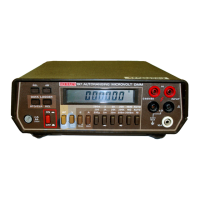2.8.1
AC
Voltage Offset
The situation changes with
the
half-wave rectified sine
wave.
As
before, the peak value of the waveform is
lOV,
but
the average value drops to
3.18V.
The
RMS
value
of
this
waveform is
5v,
but the average responding meter will @ve
3.53V
(3.18
x
1.11>,
creating an error
of
29.4%.
A
similar situation exists
for
the rectified square wave,
which has
an
average value of
5V
and an
RMS
value
of
5V.
Here,
the average responding meter gives a reading of
5.55V
(5
x
l.ll),
while the Model
197
gives a
TRMS
reading
of
5V.
Other waveform comparisons can
be
found
in
Table
2-7.
Typically, the Model
197
displays
50
counts
or
less of offset
on
AC
volts with the input shorted. This offset is caused by
amplifier noise and offset of the TRMS converter. This offset
does not affect the reading accuracy and should not be zeroed
out using the
REL
feature. Refer to Paragraph
2.7.4
step
4.
2.8.2 TRMS Measurement Comparison
2.8.3 Crest Factor
The RMS value of a pure sine wave is equal to
0.707
times its
peak value. The average value of such a waveform is
0.637
times the peak value. Thus, for an average-responding meter,
a correction factor must be designed in. This correction fac-
tor,
K,
can
be found by dividing the
RMS
value
by the
average value as follows:
The crest factor
of
a waveform
is
the ratio
of
its peak value to
its RMS value. Thus, the crest factor specifies the dynamic
range of a TRMS instrument. For sinusodial waveforms, the
crest factor is
1.414.
For a symmetrical square wave, the crest
0.707
0.637
K
=--
-
1.11
factor is unity.
The crest factor of other waveforms will,
of
course, depend
on the waveform in question because the ratio of peak
to
RMS value varies.
For
example, the crest factor
of
a rec-
tangular pulse is related to its duty cycle; as the duty cycle
decreases, the crest factor increases. The Model
197
has
a
crest factor of
3,
which means the instrument gives accurate
TRMS measurements of rectangular waveforms with duty
cycles as low as
10%.
BY
applying this correction factor to an averaged reading, a
typical meter can be designed to give the
RMs
equivalent.
This works fine as long as the waveform is a Pure sine wave,
but the ratios between the RMS and average values of dif-
ferent waveforms is far from constant, and can vary con-
siderably.
Table
2-7
shows a comparison of common types of
waveforms. For reference, the first waveform is an ordinary
sine wave with a peak amplitude of
1OV.
The average value
of
this voltage is
6.37V,
while its RMS value
is
7.07V.
If we
2.8.4 Extended F~~~~~~~~ Response
the
l.il
correction
factor
to
the
average reading,
it
can
Figure
2-9
illustrates the extended
frequency response
of
the
be seen that both meters will give the same reading, resulting
in no error in the average type meter reading.
ACV
ranges
up
to
lMHz.
2-14
Artisan Technology Group - Quality Instrumentation ... Guaranteed | (888) 88-SOURCE | www.artisantg.com

